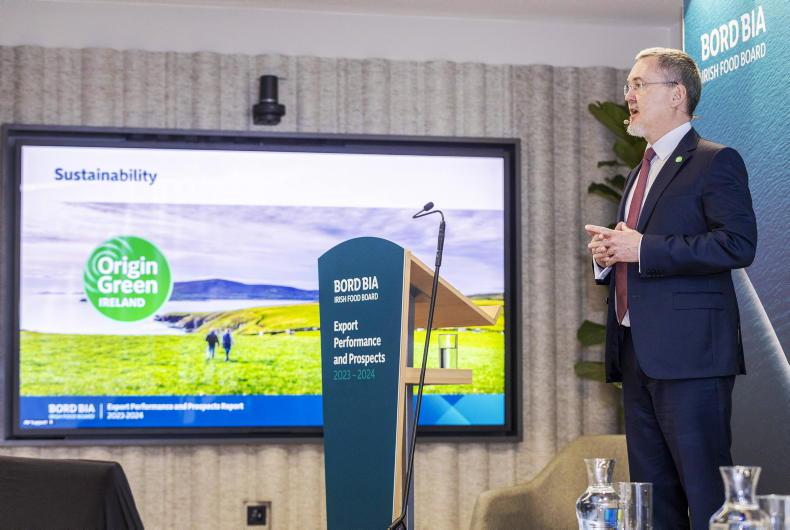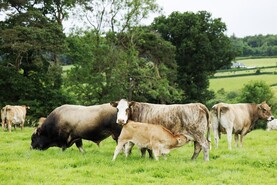A combination of lower selling prices, higher costs and difficult weather conditions made 2023 difficult for Irish farmers in all sectors.
For the agrifood industry, whose businesses are built on processing and selling the produce from Irish farms, the record highs of 2022 weren’t matched. However, it was still, as Bord Bia Chief Executive Jim O’Toole told the Irish Farmers Journal, a “solid” performance.
In our chat, the Irish Farmers Journal probed for the story behind the numbers. For beef, the striking number was that despite huge efforts to secure new markets, dependence on the UK increased in 2023, with 47% of total beef exports going to that market.
At one point in October the price differential between an Irish R3 steer and its UK equivalent was over €1/kg.
While this gap has closed in recent weeks, the Irish Farmers Journal asked Jim O’Toole if this is something Irish farmers would just have to live with, he responded that “there has always been a preference in the UK for UK beef, and tight supplies in 2023 is part of the differential.”
He also pointed to the strong performance of Irish beef price in the Bord Bia composite prime beef price comparison, with prices paid for cattle in other markets Irish beef is exported to in 2023, suggesting that the UK is the outlier.
Other markets
The Irish Farmers Journal also asked O’Toole about the performance in markets beyond the EU with beef sales falling in the US and Japan, markets that might have been expected to develop as an alternative to the UK.
He responded that “Bord Bia are flexible on where the markets are, it is about having the spread of options, and in the past year, the UK was the better market,” and that Irish beef has a “privileged position” on supermarket shelves alongside UK beef.
As for the US market, O’Toole explained that Brazil using up the tariff quota means that Irish beef is less competitive when paying the tariff. He is, however, more hopeful for lamb.
Explaining the long delay from approval to exports, this is because of veterinary protocols. “Work is ongoing and has intensified recently and when we get over the hurdle of veterinary protocols, there is a market opportunity for Irish lamb in the USA.
Turning to China, O’Toole was unsurprisingly disappointed at the enforced suspension of Irish beef exports because of the BSE case, but he was upbeat on the suspension being lifted much faster than on the previous occasion.
The evolving Chinese market was also one of the causes for closure of an infant formula manufacturing factory in 2023.
However, O’Toole believes that while there may be less opportunity with infant formula, there will still be opportunities in adult nutrition and the speciality ingredients market, where China is a huge importer.
As for pig meat, when Bord Bia led an industry trade mission to China in 2023, pig prices were strong but have since fallen. O’Toole explained that the market for imports is exceptionally weak at present, but the Irish presence in the market is well established and we are in a position to take any opportunities that may come along.
PGI and Organic
In response to a query from the Irish Farmers Journal on the difference between Origin Green and the recently acquired PGI for Irish Grass Fed beef, O’Toole explained that “Origin Green is a business-to-business communication whereas PGI is business to consumers so there is no duplication.”
As for plans on using PGI, he said that it was their ambition to be ready to go by the end of Q1 this year, and that they are currently in the process of putting the Monitoring Group in place which will be responsible for the operation of the PGI and will have farmer involvement.
As for organic promotion, O’Toole recognised that 2023 was challenging due to the impact of the cost of living crisis. He said that “Organic isn’t going to happen overnight, but Bord Bia are committed for the long term construction of markets.”
He pointed to the “Moreganic” campaign which would resume in May 2024, and the EU supported three year promotion campaign that would begin in April of this year in Germany, Austria, Sweden and Belgium.
Interestingly he doesn’t see the mix of Irish offerings that include assured, PGI and organic as competing with each other for market share, rather that they complement each other as a suite of options for customers.
Business issues
On the survey of where businesses were confident of growth in 2024, the Irish Farmers Journal noted that the US was second only to the EU despite a difficult 2023.
O’Toole pointed out that the responses were confined to companies doing business in the market at present, and turning to the threats for 2024, finance and labour were the big issues.
In addition to cost, availability of labour is an ever-increasing problem for the industry according to O’Toole, and in this respect he is of the view that we need to have an “even stronger focus on innovation, which though part of Food Vision 2030, hasn’t progressed as much as it needs to do.”
Compliance with environmental controls is a given for farmers, and the Irish Farmers Journal enquired as to the position for Origin Green factories that fell foul of the regulations. O’Toole responded that “where companies are found to have been responsible for an environmental breach, they are suspended from Origin Green pending corrective action being put in place.
If there is a prosecution by the Environmental Protection Agency, that triggers a Bord Bia investigation and suspension until the problem is resolved.
Irish grain in Irish feed
The question of Irish grain in Irish animal feed is regularly raised by tillage farmers, and when the Irish Farmers Journal raised this issue, O’Toole pointed out that our level of production isn’t enough to meet demand and there is therefore an import requirement.
He also pointed out that an accredited assurance scheme would go a long way to establish the level of Irish grain in Irish feed. That would be Bord Bia’s preferred position he said, but he also accepted that the sector isn’t currently in favour.
Funding
While Bord Bia collects levies from farmers to an approximate value of €6m annually, it secures other income mainly from Government, for the remainder of their more than €80m annual budget.
They have also successfully bid to deliver approximately €25m worth of EU promotions since 2015, but does this come with the price of diluting the promotion of Irish in favour of more generic EU branding?
When the Irish Farmers Journal put this to O’Toole, he flatly rejected the suggestion. He said “it isn’t just funding even though the EU contribution was up to 80% of total spend, but it enables Irish produce be displayed as a model of the best EU standards.”
He also added that being under the EU umbrella gave an understanding of Ireland in parts of the world not so familiar with our country.






 This is a subscriber-only article
This is a subscriber-only article










SHARING OPTIONS: